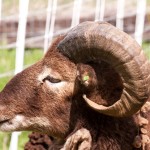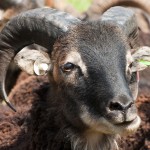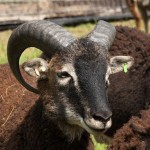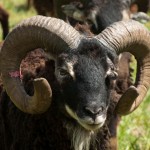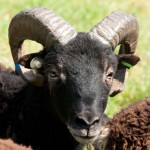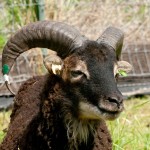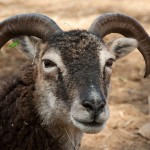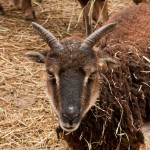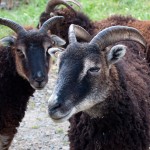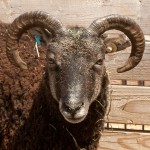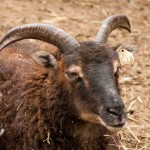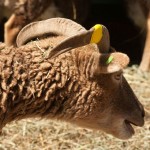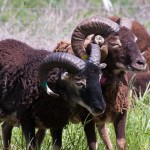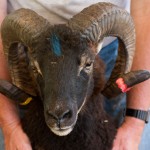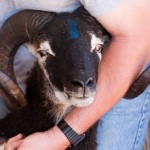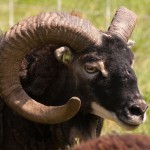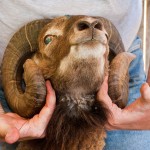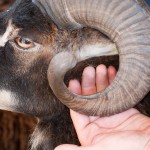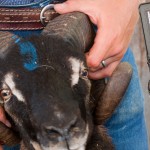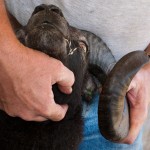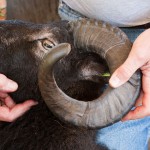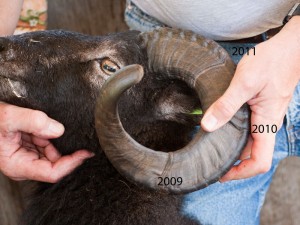Soay Sheep Horns, Part 1: How they grow and what they look like
Soay sheep horns come in all sizes and shapes. The rams may have tightly spiraled horns; thick horns of varying diameters; horns tilted at an angle before turning back in a corkscrew (or remaining in a flat plane); open, wide-angled spirals in the shape of a Celtic “M”; and everything in between. There’s more: the spiral can be parallel to the side of the head or can tilt outward or inward. A really tight spiral may lie entirely to the rear of the jaw, while a more open one can extend forward alongside the jaw.
Although we tend to think of horns as something unique to rams, one of the conveniences of raising Soay sheep is that unlike other varieties of sheep, the girls have them, too. The ewes exhibit their own array of horn conformation.
But the ewes’ horns never need cutting so they are not the focus of this post.
From time to time, generally in the first several years of a ram’s life, the developing horn set may cause problems, either because the horns grow directly into the neck or they approach the neck or jaw so closely that they interfere with head movement or eating. On the St. Kilda islands, such an animal faces a grim future. In a domesticated flock and with the assistance of an observant shepherd, the ram can survive and perhaps reproduce.
Note: This account considers the full (“British”) Soay rams only. In this population, both here and in Canada and the U.K., tight horns are not rare. Not surprisingly, the composite American Soay display some different horn shapes deriving from the portion of their heritage that is not Soay.
THE ANATOMY OF CYCLICAL HORN GROWTH
During autumn rut (breeding season), the keratinous horn sheath (keratin is the same material as fingernails) is tightly bound to the horn’s bony core, enabling the ram to compete in breeding by bashing his competitors. The whole horn structure is very sturdy, and for good reason. Little or no growth occurs during this time.
In late December, once the days begin to lengthen after the winter solstice and continuing through early spring (~March), the tissue layer between the sheath and core softens. Blood circulation increases dramatically, and the horn starts to grow. New sheath material is laid down at the base of the horn, next to the head. Meanwhile, inside the horn the bony core is also growing, gradually increasing in diameter and extending at the tip. In between these two growing layers is supporting tissue – blood vessels, nerves, etc. The sheath, which is elongating to accommodate the new growth, “slides” along the bony core, away from the head, in much the same way a fingernail “slides” off the end of a finger as the nail grows. The shape of the bony core – its angle and curvature – determines how the horn set will develop. The core serves as a mandrel, molding the keratinous sheath as it slides along, imparting curvature and twist.
Later in the spring and during the summer, all of this growth slowly comes to a stop. The tissue layer hardens, blood circulation decreases, and the sheath tightens up in preparation for the onset of rut, when the cycle repeats.
THE RARE OCCASION WHEN YEARLING RAM HORNS GROW INTO THE NECK
Despite the different kinds of horn growth activity and inactivity over a ram’s lifetime, there is only one critical time period for making sure the ram’s horns are not growing right into the ram’s neck. Yearling rams (lambs experiencing their first year’s horn growth) should be checked for horns that grow straight back rather than curving outward and then down. This happens very rarely, but when it does, the horn must be cut before it grows into the ram’s neck. Note: you are unlikely to encounter “tight” horn problems later with these guys because you will have cut off the offending tips.
WATCHING ADULT RAMS FOR TIGHT HORNS
Ram horns usually grow outwards from the head at varying angles (not straight back) and then either grow more or less straight down or curve back in alongside the jaw. Most of the time there will be adequate clearance, but to be on the safe side, all adult rams should be checked once a year for sideways curving growth that starts rubbing the ram’s neck or jaw. Any cases with tight horns should be on your watch list to be checked more than once a year.
Look for places along the ram’s jaws where wool has been rubbed off. That’s where the horn may be so tight as to need cutting. Grab the ram by the horns and check for finger clearance. If you can get a finger in between the horn and the animal’s jaw or head, do not cut. But if there is less than a finger’s clearance, or if there is a raw spot, it is time to think about cutting the horn. We have a set of pictures showing this analysis for tight horns in detail on two of our rams. I will put this evaluation in a second post forthwith.
We usually wait until the annual summer working time to cut horns unless they are creating a serious problem (e.g., the ram cannot turn his head or there is a sore, not just rubbed off fleece).
WHY NOT JUST ROUTINELY CUT HORNS THAT ARE CLOSE?
With periodic maintenance – checking all rams at least once a year and checking those on the “watch list” every three months or so – we can put off having to cut a ram’s horns. We prefer to leave well enough alone, and usually the horns do clear and turn back out. Only when a horn set interferes with the ram’s ability to eat or turn his head do we take action.
So why take a chance, why not cut the horns as soon as they get sort of close to the jaw or neck? There are at least two good reasons not to cut too soon. Close horns that do not interfere with a ram’s ability to eat do no harm, and cutting too soon will deprive you of a ram with a terrific set of spiraling horns. From a health standpoint, the tight horns may even be an advantage, either because the full horn is stronger, or because with a tight horn the ram is less likely to become entangled in some other ram’s horns or a diagonal fence bracing wire or other dangerous entanglement. Truth is, as far as we know there has been no systematic study of why natural selection on St. Kilda seems to have favored (or at least not discriminated against) tight horns. Perhaps there is a tight-horn breeding advantage we haven’t thought of yet, or the horn gene is linked to some other gene that benefits another aspect of the animal’s physiology.
I happened to be out in the ram pen one day just as two adult rams became entangled when the wide-horned ram’s horn tip slipped into the opening created by the other ram’s horn spiral.
I stayed out in the field for about 20 minutes to see if the boys could unhook themselves and they did. Over the years, we have had to wade in every so often and unhook two rams, typically during rut, of course, when they are good and smelly.
EVALUATING HORNS DURING THE ANNUAL “PHYSICAL”
My advice is to pick a warm dry day in June or July for your annual ram checkups. We do three things to each ram during this yearly ritual: vaccination, hoof trim, and horn evaluation. From these observations, we update our watch list for tight horns, and we cut any horns that simply cannot be left intact.
Last July, I took a whole bunch of pictures of our rams while Steve and Shawn were working them and discussing what the various angles and widths meant in terms of whether a cut was necessary. We hope these pictures and commentary will help you make the same assessment of your rams’ horns. Here we go:
Brampton had wide horns as a yearling, so we knew we would not have to make an early horn cut. By the age of 4 years shown here, his spiral had turned back out in a corkscrew without threatening his neck or jaw at all. He never was on our watch list because his horns never got too close to his head. I know I’m not supposed to favor one kind of horn over another because of genetic diversity, but by golly I wish I could order up a horn set out of this mold for all our rams!
When Hesket’s horns descended to form the bottom of his spiral, they never turned either in or out, but instead went straight down vertically, plenty wide. Once they reached the bottom they curved out just a little. He also was never on the watch list.
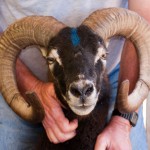
Very thick horns with unusually large diameter, unusually wide angle out of the head, and flat-plane tips
Is it any wonder Astro is our logo ram? He is 8 years old now, and he always had unusually large diameter horns and an unusually open spiral tilted toward his head, but there never has been any question about whether his horns would clear. His spiral was way forward on his face when it finally turned back up. Here’s another view of Astro’s horns, this time from the side.
Dean has tight horns, but they clear as shown by Steve’s fingers. They probably will not grow any closer but we will continue to check. Note one tip was broken in a fight or some other natural occurrence. These horns should not be trimmed but we will watch them.
Melvin has very tight horns just like his sire, Norris. As you can see, Melvin’s spiral sits pretty far back on his head, so the front of the spiral is behind the beginning of the horn where it comes out of his head, and that means that this horn is not up forward threatening his jaw. It is coming out and clearing the corner of his jaw. The bottom of his horn is the point of closest approach. Farther out on the horn it is curving away. Now compare Melvin’s horn in the next picture.
Do you see how far the tip has corkscrewed out? Because we can still pass a finger behind the tight part, this horn is okay for now and it probably will remain acceptable for Melvin’s lifetime. But his horns are pretty tight, so we will keep him on the watch list. (Sorry for the poor quality of the photo, wish I had a better one).
The next set of pictures show a horn that grows basically straight down from the initial spiral and then corkscrews outwards. It is no problem, plenty of clearance.
This is Buckley, sired by Mustard, class of 2009. His horns could have been problematic. The front of the spiral
is ahead of the point of emergence on Buckley’s head (unlike Melvin), so if the horn had turned in instead of out, it might well have created an issue with his jaw (where Steve’s finger is pointing). One more note about Buckley’s horns. You can see the yearly growth breaks, one at the bottom of the curve, one underneath Steve’s thumb joint, and one above Steve’s thumb. In the second copy of the picture, we have marked each year’s growth to show the progression.
My next post will walk you through our analysis of two rams’ horns in more detail, as well as pictures and instructions for cutting a ram’s horn.
DON’T CUT TOO SOON!
Our working notes for summer 2010 indicate we thought we might have to cut this ram’s horns, but a year later, both horns were okay even though the right one had not turned outward yet. It looks like it will clear, and our 2011 notes read, “glad we did not cut last year.” How I wish I had a picture of this ram from the 2010 working for comparison purposes. This ram, Thorington, is the son of Trenear and grandson of Chestnut, both of whom have really thick horns at wide angles and with large diameter spirals. Trenear is the fourth ram pictured at the top of the page, the one with the wide “M” horns, a characteristic white beard shared by all of Chestnut’s male descendants, and a battle-scarred left eye.
HOW OFTEN IS IT NECESSARY TO CUT A SOAY RAM’S HORN?
What, you thought I could write a post without any data in it? Wrong.
We have had 69 yearling or adult British Soay rams born here or pass through our farm for whom we have good information about the status of their horns. Of those rams, 7 have needed horn cuts, about 10%. Two of the seven were yearlings (or so) with horns growing straight towards their necks. Four of them were adults with significant horn growth still occurring, but with spirals that were close enough to impinge on the jaw. We also had one middle-aged fellow, Haines, whose horns cleared for years and then all of a sudden one winter, his horn growth took a slightly different angle and we had to cut his horns when he was 6 years old. All the rest of our adult rams have had horns more than adequate to the task without cutting, as you can see from all the pictures in this post!
Now I’m off to put together the post demonstrating a more detailed horn analysis and how to cut a horn that’s either growing straight back into the neck or that eventually gets too close to the jaw.
Stay tuned …
